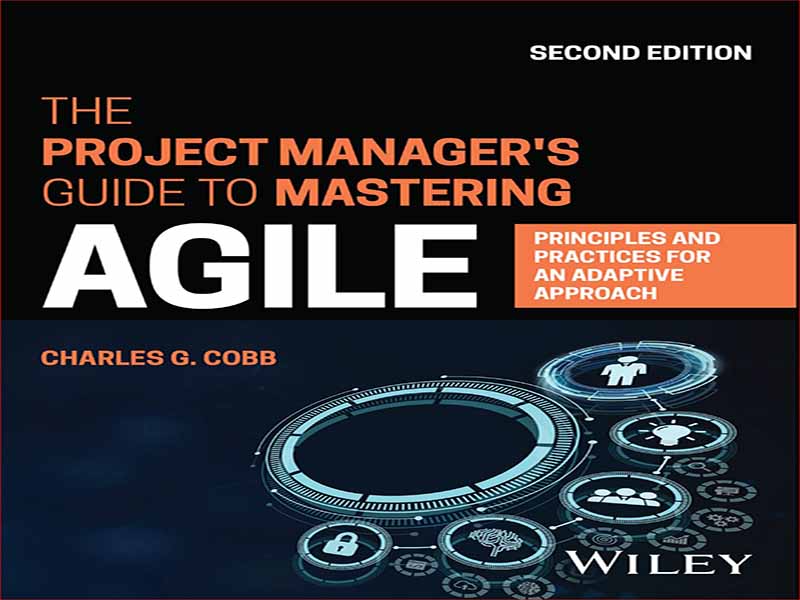- عنوان کتاب: The Project MANAGER’S GUIDE TO MASTERING AGILE
- نویسنده: Charles G. Cobb
- حوزه: مدیریت پروژه
- سال انتشار: 2023
- تعداد صفحه: 605
- زبان اصلی: انگلیسی
- نوع فایل: pdf
- حجم فایل: 9.46 مگابایت
حرفه مدیریت پروژه به دلیل نفوذ گسترده Agile تغییرات سریع و عمیقی را پشت سر می گذارد: بسیار آشکار می شود که رویکرد کلاسیک مبتنی بر برنامه در مدیریت پروژه که برای مدت طولانی روش غالباً پذیرفته شده برای انجام مدیریت پروژه بوده است. دیگر تنها راه برای انجام مدیریت پروژه نیست:
به جای تطبیق اجباری همه پروژه ها با رویکرد مدیریت پروژه کلاسیک مبتنی بر طرح، بسیار بهتر است که رویکرد را با ماهیت پروژه تطبیق دهیم.
توسعه یک رویکرد تطبیقی برای پروژههایی که سطح بالایی از عدم قطعیت دارند و/یا جایی که خلاقیت و نوآوری مهمتر از برنامهریزی و کنترل برای دستیابی به قابلیت پیشبینی هستند، بسیار مهم است. این تغییرات احتمالاً نقش مدیران پروژه را در بسیاری از محیطهایی که ما آنها را میشناسیم به طرز چشمگیری تغییر میدهد، سطح کل حرفه مدیریت پروژه را بالا میبرد و شاید حتی نقش برخی از مدیران پروژه را همانطور که میشناسیم حذف کند. از دیدگاه چابک، تغییرات به همان اندازه قابل توجهی نیز وجود دارد:
Agile و Scrum در طول سالها از تمرکز بر پروژههای کوچک و تک تیمی به پروژههای بسیار بزرگتر و پیچیدهتر در سطح سازمانی که به تیمهای متعدد نیاز دارند، رشد کردهاند.
این امر آشکار کرده است که مقیاس بندی Agile برای آن نوع پروژه نیازمند نوعی چارچوب مدیریتی کلی است که ممکن است شامل نوعی مدیریت پروژه/برنامه باشد. در هر دوی این محیطها، این درک وجود دارد که رویکردهای «کتاب آشپزی» تعریفشده و تجویزی دیگر برای مقابله با پیچیدگی این چالشها مؤثر نیستند. در عوض، نیاز به تمرکز بر تعریف اصولی وجود دارد که باید در زمینه یک موقعیت معین تفسیر شوند:
در یک محیط چابک، هر دو چارچوب چابک مقیاسپذیر و تحویل چابک منضبط از چارچوبهای نسبتاً تعریفشده به رویکردی انعطافپذیرتر و مبتنی بر اصول فاصله گرفتهاند.
در یک محیط مدیریت پروژه کلاسیک مبتنی بر طرح، نسخه 7 PMBOK از نسخه های قبلی PMBOK® که سعی می کرد فهرستی از کارهایی را که تقریباً در هر موقعیت مدیریت پروژه قابل تصور انجام می شد تعریف کند به یک رویکرد مبتنی بر اصول کمتر تعریف شده فاصله گرفته است. . حرکت به سمت یک رویکرد مبتنی بر اصول در هر دوی این محیطها مستلزم قضاوت و مهارت بسیار بیشتری برای تعیین و اجرای رویکرد مناسب برای یک پروژه خاص است. برای مدیران پروژه و حرفه مدیریت پروژه، به عنوان یک کل، بسیار مهم است که فعال باشند، محتملترین تأثیر این چالشها را پیشبینی کنند و مطابق با آن سازگار شوند. همچنین برای جامعه Agile مهم است که نیاز به مقیاسبندی رویکرد چابک برای مدیریت پروژههای بزرگ و پیچیده در سطح سازمانی را تشخیص دهد. این موضوع تعدادی سوال را ایجاد می کند از جمله:
نقش مدیریت پروژه در یک پروژه Agile چیست؟
آیا اصول و شیوه های مدیریت پروژه کلاسیک با اصول و شیوه های Agile در تضاد هستند؟
برای گسترش اصول و شیوههای Agile به پروژههای بزرگتر و پیچیدهتر در سطح سازمانی که به تیمهای متعدد نیاز دارند، چه باید کرد؟
چگونه یک مدیر پروژه معمولی شغل خود را شکل می دهد تا در جهت چابک تر حرکت کند؟ این نیازها و چالش هایی است که این کتاب در نظر گرفته شده است به آنها بپردازد. این کتاب باید هم برای مدیران پروژه و هم برای متخصصان چابک ارزش داشته باشد تا رویکردی یکپارچهتر ایجاد کند.
THE PROJECT MANAGEMENT PROFESSION is going through rapid and profound changes due to the widespread influence of Agile: It is becoming very apparent that the classical plan-driven approach to project management that has been the predominantly accepted way of doing project management for a long time is no longer the only way to do project management:
Rather than force-fitting all projects to a classical plan-driven project management approach, it is much better to fit the approach to the nature of the project.
It’s particularly important to develop an adaptive approach for projects that have a high level of uncertainty and/or where creativity and innovation are more important than planning and control to achieve predictability. Those changes are likely to dramatically change the role of project managers in many environments as we have known them, raise the bar for the entire project management profession, and perhaps even eliminate the role of some Project Managers as we have known them. From an Agile perspective, there have also been some equally significant changes:
Agile and Scrum have grown over the years from a focus on small, single-team projects to much larger and more complex enterprise-level projects requiring multiple teams.
That has made it evident that scaling Agile for that kind of project requires some kind of overall management framework which might include some kind of project/program management. In both of these environments, there is a recognition that well-defined and prescriptive “cookbook” approaches are no longer effective for dealing with the complexity of these challenges. Instead, there is a need to focus on defining principles that need to be interpreted in the context of a given situation:
In an Agile environment, both the Scaled Agile Framework and Disciplined Agile Delivery have moved away from relatively well-defined frameworks to a more flexible, principles-based approach.
In a classical plan-driven project management environment, PMBOK® version 7 has moved away from previous versions of PMBOK® that attempted to define a checklist of things to do in almost every conceivable project management situation to a less well-defined principles-based approach. The movement to a principles-based approach in both of these environments will require a lot more judgment and skill for determining and implementing the right approach for a particular project. It is critical for Project Managers and the Project Management Profession, as a whole, to be proactive, anticipate the most likely impact of these challenges, and adapt accordingly. It is also important for the Agile community to recognize the need to scale an Agile approach for managing large, complex enterprise-level projects. This raises a number of questions including:
What is the role of project management in an Agile project?
Are classical project management principles and practices in conflict with Agile principles and practices?
What needs to be done to extend Agile principles and practices to larger and more complex enterprise-level projects requiring multiple teams?
How does a typical Project Manager shape his or her career to move in a more Agile direction? Those are the needs and challenges that this book is intended to address. This book should be of value to both project managers and Agile professionals to develop a more integrated approach.
این کتاب را میتوانید از لینک زیر بصورت رایگان دانلود کنید:



































نظرات کاربران